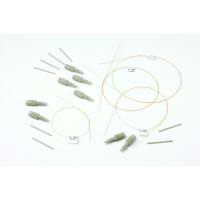Capillary Electrophoresis Separation of Ribonucleosides
互联网
574
Electrochemical detection (ED), primarily because of the extraordinary sensitivity and unusual selectivity, has established itself based on the characteristics of microelectrodes as one of important detection methods for capillary electrophoresis (CE) (1 ). Compared with the popular spectrometric detection techniques, the advantage of ED derives from the fact that the sensitivity of analyte detection is not hampered by the small volumes of the sample zone which limit the signal strength. This problem is frequently encountered in CE using spectrometric detection (2 ). In order to realize this significant potential of ED in practice, two principal difficulties must be overcome. First, there is the need to diminish the influence of the high voltage employed in the CE separation on the electrochemical detection potential. This problem was solved initially by placing a small fracture near the downstream end of the separation capillary, and covering the crack with a porous glass (3 ), or Nafion� (4 ) coating. This procedure permits this point of the capillary to be held at ground, but maintains the electroosmotic flow (EOF) out of the end of the capillary, without any detrimental effects to the electrophoresis current. It has been shown (5 ) that when the smaller diameter capillary columns (i.e., less than 25 μm) are employed, the electrophoresis current and associated iR drop in the detection cell are both small. The effects are small enough in most cases that the exit end of the capillary column can simply be placed into the electrochemical cell, very near the working electrode surface. Secondly, microelectrodes comprising 5–50-μm wires, or fibers were initially employed in order to match the size of the separation capillary. This fabrication has to be accomplished under a microscope. This requirement greatly complicates electrode fabrication, as it makes the alignment of the electrode and capillary difficult to maintain during an electrophoresis run, and during subsequent runs. Experimental reproducibility is thus difficult to maintain with such fine electrodes.








